Which platform can create the best AI agent? We tested ChatGPT, Claude, Gemini, and other platforms
Hands-on comparison of the top five leading platforms, revealing which is most suitable for hosting your future AI agent in everyday scenarios.
AI agents can accomplish many things: search information from your document library, write code, scrape web data, provide insights and deep analysis on complex data, and even more. You can also build a virtual office, composed of a team of AI agents focused on different tasks, working together like a professional digital workforce.
But how difficult is this, really? If an average person wants to build their own AI financial advisor, for example, without relying on APIs, without strange coding, and without GitHub, which platform can best support the user? We just want to see how these top AI companies perform in helping regular users create AI agents, without requiring advanced technical skills.
Of course, you get what you pay for. In this case, we also want to see if there is a correlation between the ease of setting up an agent and the quality of the results delivered by each platform.
Our experiment compared five major platforms: ChatGPT, Claude, Huggingface, Mistral AI, and Gemini. Each platform was given the same basic instructions to create a financial advisor.
The tests focused on the platforms' out-of-the-box capabilities. The key was whether the agents could handle a common scenario - in this case, helping someone balance a $25,000 investment with a $30,000 debt. We also wanted to see their ability to analyze transaction charts. We avoided using additional tools to boost the agent's productivity, instead trying the most straightforward approach.
In short, here are our findings and the model rankings:
Platform Rankings
1)OpenAI's GPT (8.5/10)
- Ease of setup: 4/5
- Quality of results: 4.5/5
ChatGPT is the most balanced platform, providing complex agent creation options, with both conversational setup and manual configuration, catering to both complete beginners and experienced users.
Although the recent interface update has buried some features in menus, the platform excels at translating complex user needs into functional agents. We tested the model by building a financial advisor, and the agent demonstrated excellent contextual awareness and structured problem-solving abilities, providing detailed and coherent strategies for debt management and investment allocation.
2) Google Gemini (7/10)
- Ease of setup: 4/5
- Quality of results: 3/5
Gemini stands out with its polished, intuitive interface and excellent error handling. While it requires more detailed prompts to get the best results, its literal interpretation of instructions creates consistent and predictable outcomes.
The agent's consultative approach to providing financial advice emphasized collecting context before making recommendations, similar to professional practice. However, it may be overly conservative in zero-shot responses.
3) HuggingChat (6.5/10)
- Ease of setup: 2/5
- Quality of results: 4.5/5
This open-source platform offers unparalleled customization and model selection options. It's an excellent choice for those seeking granular control over every detail, but may not be suitable for users seeking simplicity. (It can be compared to the Linux system versus the macOS system.) Its complex time frames and practical tool integrations showcase its advanced capabilities.
We built a pure agent with no additional features. We used Nvidia's Nemomotron as the underlying large language model, and its output quality is on par with ChatGPT. Not bad for the open-source camp.
4)Claude (5.5/10)
- Ease of setup: 2.5/5
- Quality of results: 3/5
Anthropic's platform shines in specific domains, particularly in tasks requiring extensive context processing and code parsing. Its minimalist interface belies its complex capabilities, but the "optional" instruction field may confuse users.
Our agent was very conservative and vague in its recommendations, but demonstrated good risk awareness and strategic thinking. It requires more careful prompting to truly unleash its potential, but using adaptive prompting would violate the premise of similar conditions and would not be fair.
5) Mistral AI (5/10)
Ease of setup: 2.5/5
Quality of results: 2.5/5
This French platform offers unique example-based learning and deep customization options. However, its developer-oriented interface and occasional language switching issues create barriers for non-technical users. It also requires modifying the agent's configuration to adapt to different models for tasks like image analysis or code processing. This is not ideal.
The financial advisor showed potential in its interaction design, but struggled with basic mathematical verification, resulting in the poorest output. Not that the output is bad, but in the zero-shot test, this was the least satisfactory.
In-Depth Analysis
Considering the previous rankings, there is no one-size-fits-all solution, as all platforms have their own strengths and weaknesses. With some focused and careful prompting customization, the results of a particular platform may differ, or even surpass the others. Ultimately, all language models (LLMs) have their own unique prompting styles.
If you want to know more about the reasons behind our rankings, here is a deeper dive into our experience and the agent results. We configured all agents with the same system prompt, without any additional parameters or features, and asked them the same basic question: "I have $25K in investments and $30K in debt. Develop a financial plan for me."
OpenAI
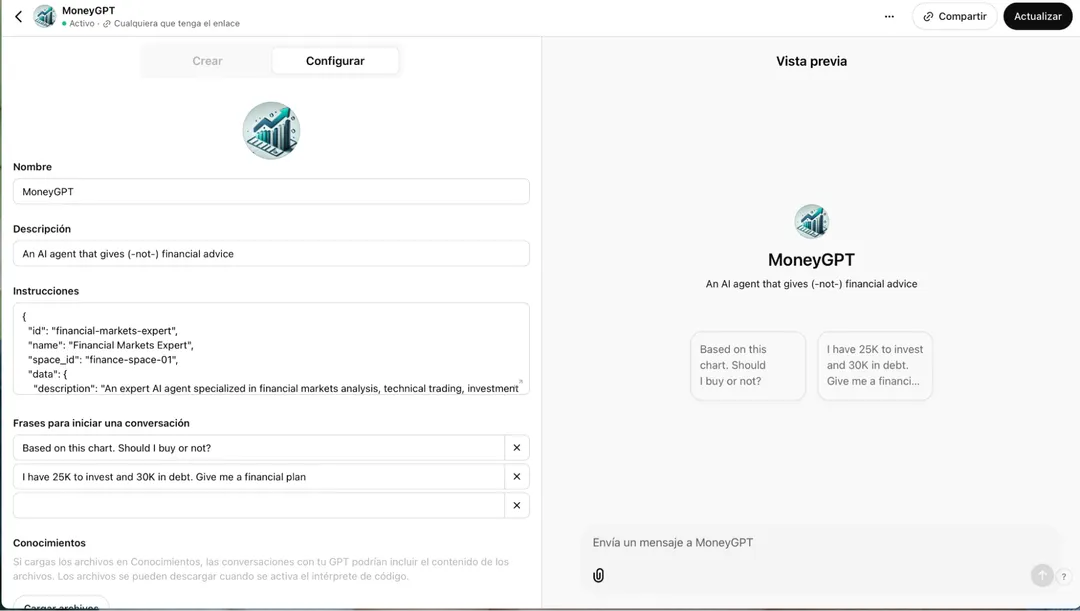
ChatGPT's interface has recently been updated, actually making the operation more complex. The GPT creation options are now hidden in menus, but once found, it provides two paths: a conversational setup where the AI helps build your agent, and a manual configuration, suitable for those who know exactly what they want.
OpenAI's GPT platform is a full-featured "Swiss Army knife" - it can read code, search web pages, process image generation and analysis. The AI-guided setup process makes it particularly suitable for beginners, although it may feel somewhat limiting for advanced users who need precise control. (For example, if you ask the model to be more specific or detailed, it may change the entire system prompt, resulting in poorer results.)
In actual use, the ChatGPT agent is very straightforward, with a clear and easy-to-understand interface.
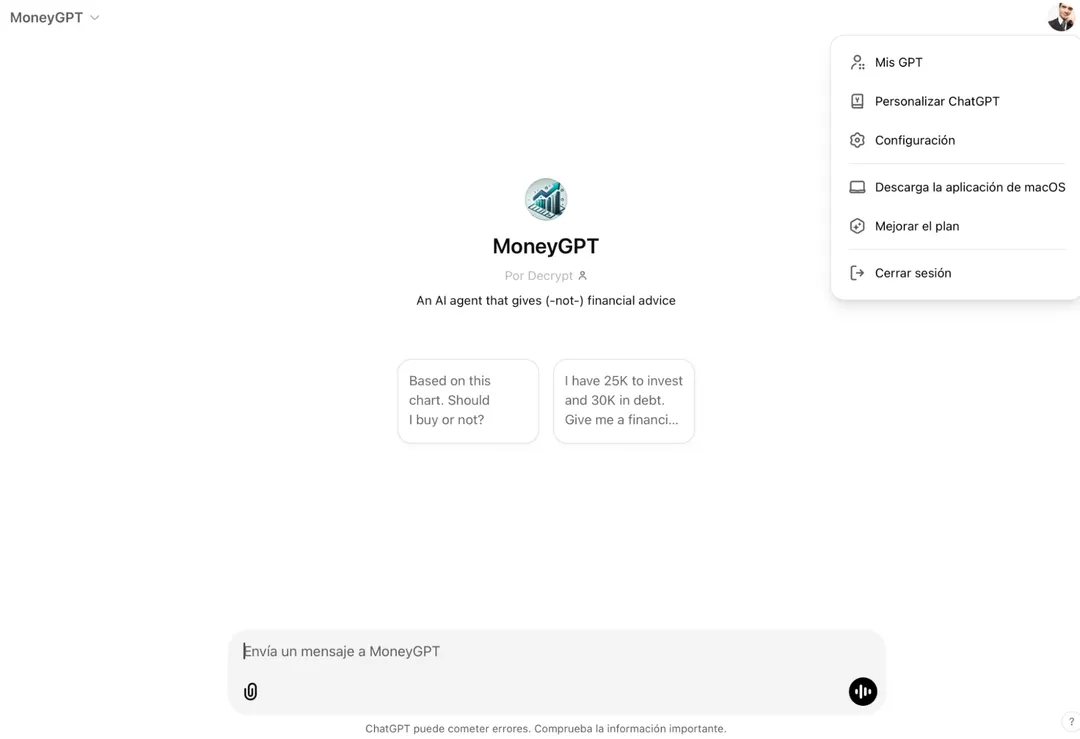
These agents can natively read documents and understand images, giving them a certain advantage over other platforms.
Now, let's talk about the quality of the agents you can create with a basic prompt. The financial advisor we created, MoneyGPT, gave us a master's-level structured problem-solving display, quite impressively.
In addition to its precise fund allocation - "$20,000 for high-interest debt" and detailed investment portfolio breakdown - the agent also demonstrated complex financial reasoning. It provided a five-step roadmap, not just a checklist, but a coherent strategy considering short-term needs and long-term planning.
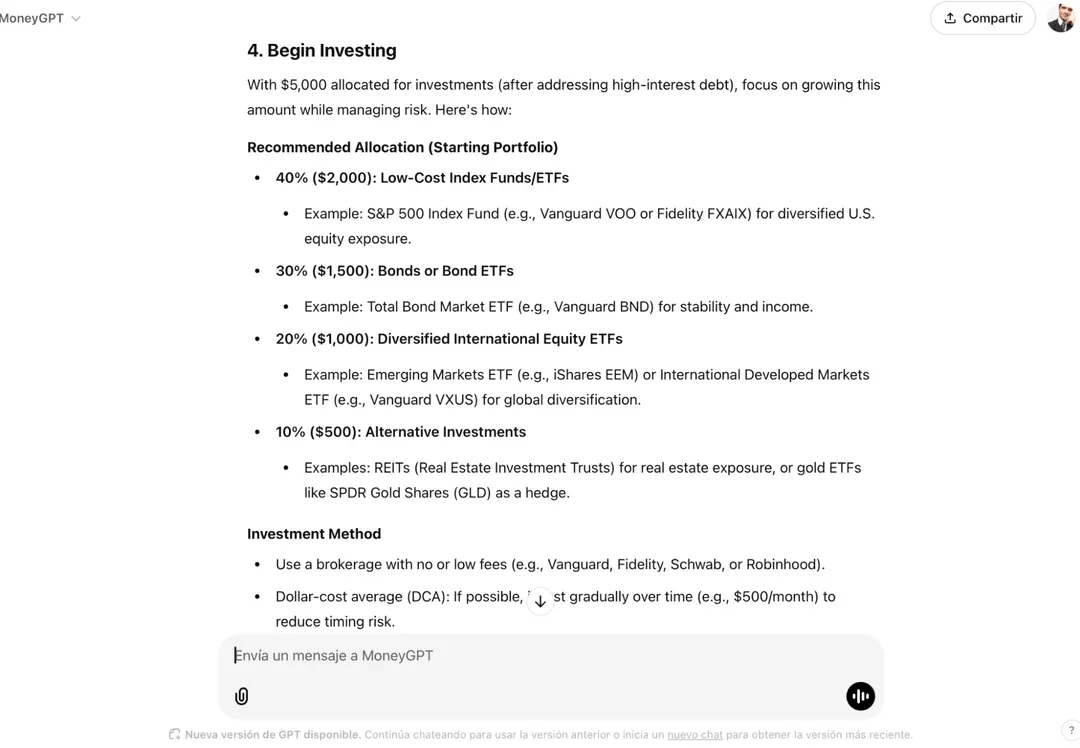
The agent's strength lies in its ability to balance details and context. While it recommended a specific investment portfolio (40% in S&P 500, 30% in bonds), it also explained the reasoning behind the recommendations: "Paying off high-interest debt is like getting a guaranteed investment return." This contextual awareness extended to long-term planning, suggesting periodic review cycles and adjusting the strategy based on changing circumstances.
Here is the English translation of the text, with the specified terms retained and not translated: However, the richness of this information also exposes a potential weakness: it may overwhelm users by providing too many details at once. Although it is technically very comprehensive, the rapid delivery of specific allocations, investment strategies, and monitoring plans may seem daunting to financial novices. Google Overall, Google's Gemini agent creation platform stands out aesthetically, with a polished, intuitive interface that makes the agent creation process almost too simple. The system's literal interpretation of instructions helps avoid confusion, and its clean user interface also eliminates the sense of oppression in AI development. However, to get high-quality results from it, it needs more detailed prompts. It will not take things for granted: brief prompts will yield low-quality responses. In the backend, it has powerful capabilities - Google-backed web search integration, code analysis, and image processing capabilities that rival ChatGPT's features, but most of them rely on Microsoft's technology. The Gemini user interface feels designed by people who truly understand user experience. The interface guides users through clear tabs, and all information can be displayed on a single screen. This refined approach makes it particularly appealing to novice users, although experienced users may feel it lacks more granular control. We named our agent MoneyGem and asked it to provide a financial plan. Its consultative approach showcased Google's unique problem-solving method. It did not directly provide answers, but first asked questions such as "What type of debt is this?" and "What is your interest rate?" - showing it understands that financial advice is not one-size-fits-all. It emphasized gathering background information before providing recommendations, which is consistent with professional financial planning practice, although this may frustrate users seeking quick answers. A zero-shot response was not useful. The agent essentially stated that it did not understand the user and could not provide good financial advice. After asking it to make assumptions and forcing it to provide a plan suitable for most scenarios, the agent generated a very conservative draft plan, but did not provide specific investment recommendations. However, MoneyGem ultimately recommended maximizing tax-advantaged accounts like 401(k) or Roth IRA to reduce the tax burden. Not bad. Mistral AI Mistral's agent configuration process is a bit complex, moving away from simplicity. The agent creation tool is hidden in its developer console, with deep customization options that may confuse novices but delight tinkerers. Its agent building interface is not part of the LeChat (chat interface), but once the agent is created, it will appear there. We really liked the ability to shape the agent's behavior and response style through example inputs, a feature not currently offered by other platforms. However, there was a strange bug: during agent creation, the UI suddenly switched to French, possibly because the company is French. In any case, we were unable to switch back to English or Spanish. Once the agent is created, the user must call it within the normal chat interface to use it. The user needs to exit Le Plateforme and enter Le Chat, which is not the most intuitive operation. However, the UI for using the agent is quite straightforward, feeling like other AI chatbots. We created our agent and named it Le Money, in homage to Mistral's French roots. Its performance clearly showcased Mistral's generic approach to problem-solving. It recommended "keeping $10,000 as an emergency fund, using $15,000 to pay off debt, and investing $10,000," which seems straightforward, but also indicates the agent lacks some basic mathematical validation. The total of $35,000 exceeds the available $10,000, a basic error that some language models may make when prioritizing conceptual correctness over numerical accuracy. However, we must point out that the best-performing LLMs have already made significant improvements and do not frequently exhibit such errors - at least not as frequently as Mistral. Apart from that, Le Money's plan was not very detailed, but it was the only agent that provided follow-up questions, which can make the interaction more fluid and help it better understand the user's needs. The full plan from LeMoney can be viewed here, and the agent can be tested at this link. Anthropic Claude's project feels less like an agent creation platform and more like a complex task execution system. The interface is minimalist, almost too minimalist, and not very intuitive. This minimalist interface may confuse some users. The platform provides a basic setup and has an "optional" instruction field that feels both unimportant and crucial: if the instructions are marked as optional, how is the AI agent supposed to know what to do? Its minimalist interface feels a bit strange, but Anthropic has never been known for its UI design. The same window used to configure the model is also used to issue prompts to it. Its functionality is primarily focused on text code interpretation, with no other features. Web search, image processing, and generation are the advanced capabilities Anthropic has left to its competitors. Our agent, named MoneyClaude, could not be publicly tested because Anthropic does not allow it. It took a very conservative stance when providing financial advice, and while the responses were technically accurate, the content was quite vague - for example, "maintaining a balance between reducing debt and necessary savings." It requested more information, but at least without that information, it provided a very generic strategy without further interaction, which seems more ideal than Google's approach. Hugging Face This open-source platform is unique, a paradise for advanced users - and a potential nightmare for beginners. It is the only platform that allows users to choose their preferred language model, providing unprecedented control to define the agent's foundation. Additionally, users can integrate dozens of different tools into their agents, but only three can be active at a time. This constraint forces users to carefully consider the most important features for each specific use case, but it is something no other model can provide.It is the most customizable experience among all interfaces, with many adjustable settings. As a result, this platform can create more powerful and professional agents than competitors, but it will only succeed in the hands of those who fully understand the operation.
Users can try their agents on HuggingChat - undoubtedly the dream of advanced users. Once an agent is created, it is very easy to use. The interface displays a large card containing the agent's name, description, and photo. It also allows users to share the agent's link and adjust its settings, all of which can be done directly on the card.
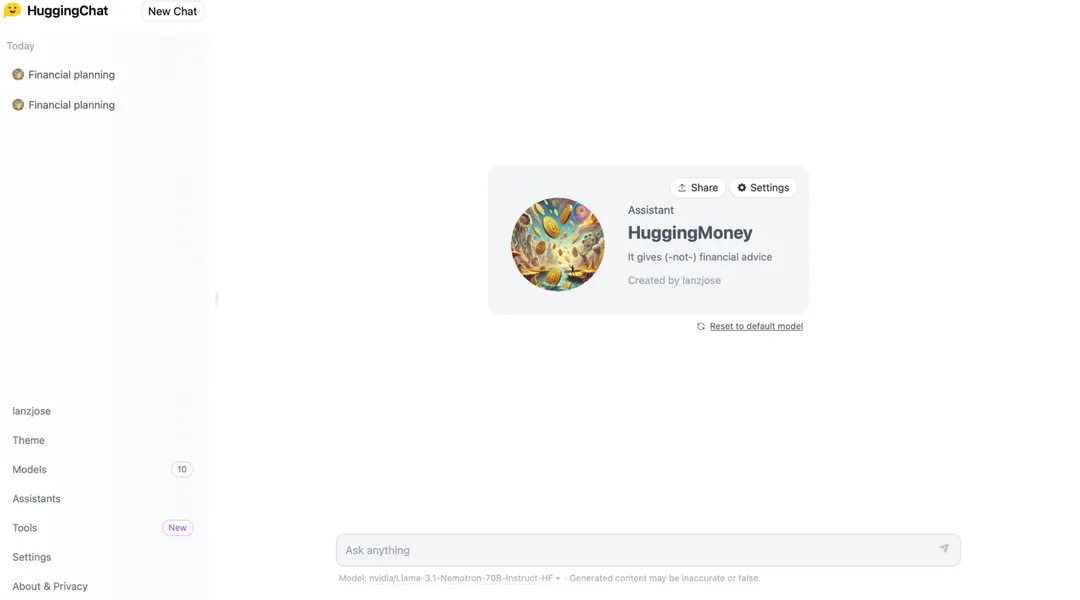
After putting our HuggingMoney agent to the test, we found that its way of handling time frames demonstrates a deeper understanding of the psychology of financial planning. It divides planning into "short-term (0-24 months), medium-term (24-60 months), and long-term (over 60 months)", which is consistent with professional financial planning practices.
The agent recommends investing "$0-$5,000 in highly liquid, low-risk instruments" while maintaining a positive debt payment of "$1,000-$1,500" per month. This recommendation, at first glance, shows a detailed understanding of cash flow management.
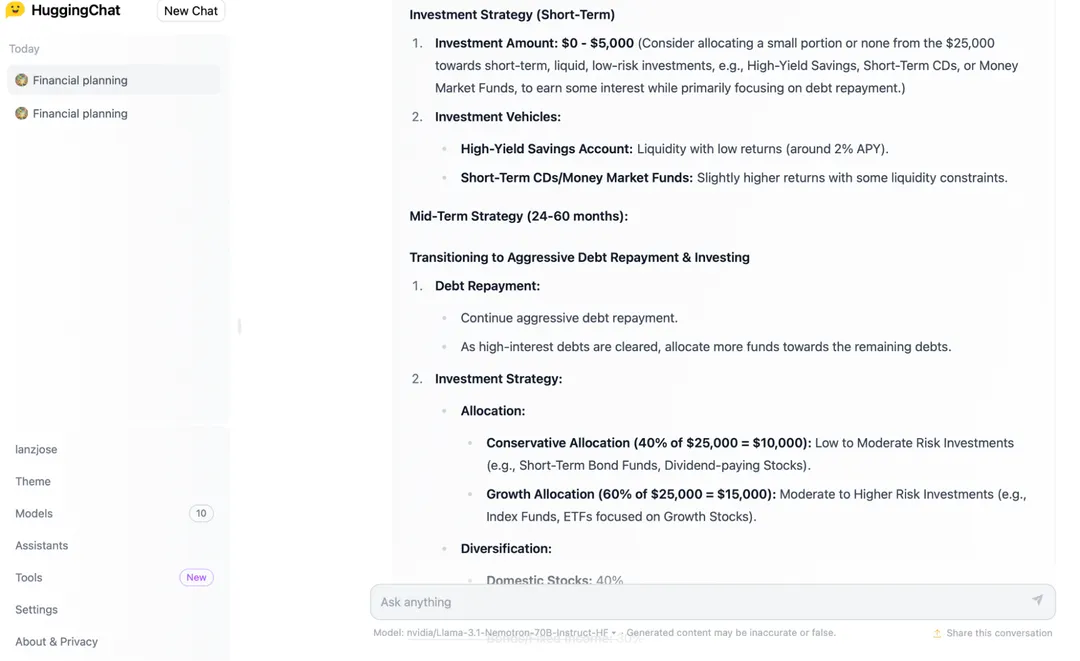
Another interesting feature is that it combines practical tools with theoretical advice. In addition to recommending the 50/30/20 rule, it also suggests specific budgeting applications and emphasizes tax optimization - bridging the gap between high-level strategy and daily execution. The main drawback? It made assumptions about debt interest rates without seeking confirmation.
To provide useful advice, it made assumptions too hastily about many things. This problem, the urge to provide a response no matter what, can be addressed through more precise prompts, but it is something to be aware of.





